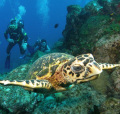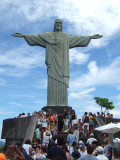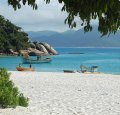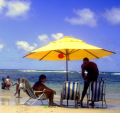Florianopolis
 Friday, February 5, 2010 at 06:56AM
Friday, February 5, 2010 at 06:56AM
Florianopolis (or Floripa for short) is the Capital city of the state of Santa Catarina. It is famed for its amazing beaches and beautiful landscapes. The City itself lies partly on the Mainland (12 km2), but mainly on the Island of Santa Catarina (425km2). With over 40 beaches to choose from, it has become one of the leading tourist destinations in Brazil. Those Brazilians wanting a quieter and less hectic pace of life than in Rio or Sao Paulo often head here as its location is not too far away from either, but far enough away to be much more relaxed. It is one of the wealthiest per capita states of Brazil, so offers modern, contemporary shopping malls as well as rustic charm. There are many chic restaurants and bars here and a vibrant nightlife as well as pristine, untouched nature reserves and sleepy little fishing villages. Its high end and chic shopping areas along the beached is reminiscent of Miami South beach. It is hardly surprising it has become a haven for Brazilian and international tourists alike – something for everyone? Situated just off the South coast of Brazil, the island has 2 bridges connecting it to the mainland, only one of which is still operating. The closed bridge has now become a postcard picture for tourists and the suspension bridge is likened to Golden Gate Bridge. Florianopolis Beaches & Restaurants by Pearl Travel Guide Larger Map See also the Inerative Map of hotels, posadas and villas Archaeological sites have traced the existence of Carijós Indians of the nation Tupi-Guarani up to 4000 years ago and these are believed to be the first inhabitants of Florianopolis area. The Indians called the place Meiembipe or "mountain along the channel". Around 1514 the Portuguese landed and gave the area the name Ilha dos Patos, but in 1526 it was renamed Ilha de Santa Catarina. In 1673 the arrival of bandeirante (slave hunter) Francisco Dias Velho led to the first settlement and construction of the first chapel consecrated to Nosso Senhora do Desterro around 1678. However to maintain the domain, the Portuguese Crown elevated Santa Catarina Island to the Status of ‘village’ in 1714 and further elevated in to a ‘town’ in 1726. Up until 1894 Florianopolis was called Nossa Senhora do Desterro (our Lady of Banishment). The name was changed as a tribute to the second President of the Republic of Brazil (1891-1894) – Floriano Peixoto. Originally founded on March 23rd1726 by settlers from the Azores off Portugal, it has a rich history and you can still hear some of the locals speaking in an Azorean dialect in the more remote parts. March 23rd is a date that is still celebrated annually by the locals. The coastline is scattered with fortresses built to repel the invasions by the Spanish and the Dutch in the 16thand 17th Centuries. There is much colonial architecture to enjoy including the Heritage site of the Fortress of São José da Ponta Grossa. In the centre of the City lie ancient examples of its historic architecture. The Governors Palace now houses the Cruz e Souza Museum (a famous poet from Florianopolis and founder of the symbolist movement) and the public market built in 1898 are here. The later being a great place to buy local handicrafts under the shade of a 100+ year old fig tree. Also close to the centre is the house where Victor Meirelles was born. The house is now a museum to the man credited with writing the first mass spoken in Brazil. Swimming with dolphins is high on a lot of people’s wish list nowadays and here on Florianopolis you can do just this in the warm tropical waters. Most activities on offer here centre on the water, whether it is jet skiing, surfing, snorkelling or scuba diving. An idyllic way to spend a few hours is to hire your own boat and head out to sea, drop anchor and just let the waves lap away at the boat – utter tranquillity. The newest adrenalin rush to be had here sounds weird, but it is well worth trying it out for yourself, and costs relatively little. Sandboarding! Hire a board (approx R$1.50) and hit the massive dunes at Joaquina Beach. Try keeping your balance and controlling the board across these 10 foot high sand barriers. If you fall off, no harm done, just pick yourself up, dust yourself down, and start all over again! The beaches by day and the clubs and bars by night are the real stars of this island, and there are plenty of both for every visitor. Huge Atlantic swells of warm water mixed with great temperatures attracting surfers from all over are not the only draw for Balneario Camboriu. This area of natural beauty boasts a forest that is home to indigenous plants and flowers as well as wild birds. There is a beautifully maintained beach area where the local fishermen head for their prized catches. So if you are into fishing you can take the opportunity to land some catches you probably won’t see anywhere else. This is also true of Garopaba where you can participate in some hard-hitting sport fishing or other water sports such as windsurfing or body boarding. Or for the more adventurous why not hang-glide from the cliff tops and fly out over the ocean. Then relax with the locals and party on one of the eight beaches! Those of you who would prefer to delve into the history of the Island should visit Fort Santana, one of the best monuments, situated at the foot of the Hercilio Luz Bridge. It also houses the Museum of Weapons of the Military Police. On top of the Morro das Pedras (Hill of Stones) lies the Jesuit Monastery. This is a spectacular sight, and the sights from here across the nature reserve of Logoa do Peri are also spectacular! Two other popular tourist attractions are the Museum of Anthropology and the Museum of the Sambaqui people (inside the Colegio Catarinense). The former housing skeletons and cooking utensils etc of the native Indians of the Atlantic Coast, the latter holding similar artefacts of indigenous folk. The Cathedral in Florianopolis is believed to have been constructed in the year 1761 to commemorate the good works of Joao and Maria. The Cathedral of Florianopolis houses some impressive statues of Joao and Maria – this is situated near Praca XV de Novembro. Accommodation on the island covers a wide range of prices. Choose your preference from our listings for Budget accommodations (from under R$150 per night), Moderate accommodations (from R$150-400) per night) and Luxury accommodations (over R$400 per night). These are guide prices based on the cost of a double room. For those of you wishing to have more privacy or a ‘home from home’ feeling there are also some Villas and Vacation Homes listed. You may want to choose your accommodation by it´s location. We have mapped all the accommodtion and colour coded the markers so that you can select by price and location. Check out the interactive accommodation map Tours in Florianopolis can be exhilerating (surfing, kitesurfing, rafting, sandboarding and biking), or relaxing (yoga or a boat trip). Yoga and Surf combines the two. Many others are nature and wildlife focused (whale and dophin watching, birdwatching and hiking). For sure there is plenty to do. Get tour details & book online You will find bars and cafes dotted all along the beaches and many more in the downtown area. There really are lots of places to eat and drink and people watch or see the sun setting – You’ll find your own favourites no doubt. Wherever you go you will find great Brazilian friendliness and charm, with warm smiles and cold drinks. Florianopolis cuisine as you would probably expect, being an island, is very seafood orientated. You can find shrimp cooked many ways here (fried, steamed, etc). You can even have the ‘sequencia de camarao’ – a sequence of shrimp dishes in various forms. You will also find references to ‘cultura acoriani’ which is cooking influenced by the culture of the Portuguese Azore islands. Tainha which is similar to mullet is a delicacy here in the winter months. It is usually stuffed and baked and served with rice. Other cuisines are slowly finding their way into the area, so you can now enjoy Italian, Japanese and Mexican dishes as well as fast food outlets in the city centre. Full details of our restaurant recommendations will be published soon. Florianopolis is blessed not only with incredible natural beauty, but also with some of the best nightlife in South America - possibly the world . According to founder of Nexus Surf “Florianopolis night life blows away night life in L.A. or New York or anywhere else”. From stylish beach bars, to chic cocktail lounges and cavernous mega clubs, Floripa offers nightlife for all budgets and staying powers. Essentially it is a mix of the partying of Ibiza mixed with the sophistication of St Tropez, but without attitude and overinflated prices. Party capital of the island has to be Jurere in the north. Party gurus arrive in flash sports cars or even private helicopters, dressed in the latest fashion clothes and accessories. It is home to Praia Café (Avenida dos Merlins; 48-3282-1325 www.praiacafedelamusique.com.br), where the parties go until 4 a.m. You’ll also find the champagne served to bronzed beauties draped on white canopy beds here at Parador 12(Servidão J. Cardoso Oliveira; 48-3284-8156; www.eldivinobrasil.com.br). Or for a mega club with the funkiest sounds from famous DJ’s try Pacha (Rodovia Maurício Sirotsky Sobrinho; 48-3282-2054;www.pachafloripa.com.br) Over at Praia Mole the surfers who enjoy the long strip of beautiful beach and world class waves set their boards down and head to one of the many beach bars. Most notably Barraco da Mole with its live music and DJ sets. The ultra chic town of Lagoa da Conceicao centres its evening social scene around the stylish Information Confraria das Artes nightclub (Rua João Pacheco da Costa 31; 48-3232-2298; www.confrariadasartes.com.br). This beautiful club is set in an amazing colonial pad with vintage furniture galore. Attracted here are Brazil’s intellectuals, artists and media types. The Gay scene here is thriving and is said to be Brazil’s 3rd best location for gay nightlife. The first gay cruise in Brazil operates from Praia Mole. For the week of Carnival many Sao Paulo and Rio clubs open temporary clubs here – check out Praia Mole Eco Village Hotel. (Rodovia Jornalista Manoel de Menezes 2001; 48-3239-7500; www.praiamole.com.br). We provide two types of information; Basic Information and Advice. (Coming Soon) Hercilio Luz International Airport is the name of the airport in Florianopolis. It is served by several domestic and international airlines. For details of airlines currently serving Florianopolis airport see SkyScanner. Here you can also get live information about arrivals. The airport phone number is +55(0)48 331400 The major bus terminal in Florianopolis is Terminal Rita Maria: Tel: 3212-3100, email: getrm@deter.sc.gov.br. It is served by many bus companies with routes to many other Brazilian and international destinations. If you are travelling by car we suggest using GoogleMaps. Click the "Get Directions" button, enter your origin and destination, then click the click the second "Get Directions" button. You will have detailed instructions, distances for each part of the journey and an estimated travelling time by car. 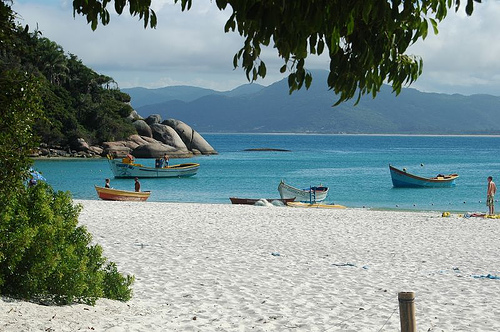 Ilha do Campeche photo by R i c a ® d O
Ilha do Campeche photo by R i c a ® d OMaps
Short History
 Being about half way between the two largest coastal cities in South America, it grew in significance as a defensive Port and formed part of the defensive ring of South America. Therefore in 1739 the Capitania da Ilha de Santa Catarina was created and Desterro became its capital. This lead to an increase in population between 1747 and 1756 with up to 6000 settlers arriving from the Azores and Madeira off Portugal.
Being about half way between the two largest coastal cities in South America, it grew in significance as a defensive Port and formed part of the defensive ring of South America. Therefore in 1739 the Capitania da Ilha de Santa Catarina was created and Desterro became its capital. This lead to an increase in population between 1747 and 1756 with up to 6000 settlers arriving from the Azores and Madeira off Portugal. 1893 saw the change of the state capital´s name from Desterro to Florianopolis, that is to say, city of Floriano. The name change was in respect of the Iron Marshal Floriano Peixoto who contained the rebellion of the Federal Revolt, which spread to Santa Catarina from Rio Grande do Sul. At the time he was the President of Brazil and ordered the shooting of the Federalists who were considered enemies of the state and had declared Desterro as the Federal Capital of the Republic.
1893 saw the change of the state capital´s name from Desterro to Florianopolis, that is to say, city of Floriano. The name change was in respect of the Iron Marshal Floriano Peixoto who contained the rebellion of the Federal Revolt, which spread to Santa Catarina from Rio Grande do Sul. At the time he was the President of Brazil and ordered the shooting of the Federalists who were considered enemies of the state and had declared Desterro as the Federal Capital of the Republic. Fortaleza de São José da Ponta Grossa. Photo by Andre Egreja.
Fortaleza de São José da Ponta Grossa. Photo by Andre Egreja.Do Not Miss
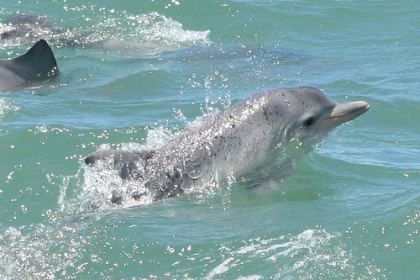 Photo by Gislaine Fotos.
Photo by Gislaine Fotos. Photo by juxyz | Julia Rodrigues.
Photo by juxyz | Julia Rodrigues.Other Top Attractions
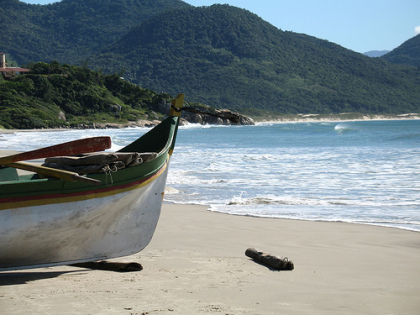 Garopaba Beach. Photo by max the dog.
Garopaba Beach. Photo by max the dog. Lagoa do Peri. Photo by corrupiola | leilalampe.
Lagoa do Peri. Photo by corrupiola | leilalampe.Accommodation
Florianopolis Accommodation by Pearl Travel Guides Larger MapTours
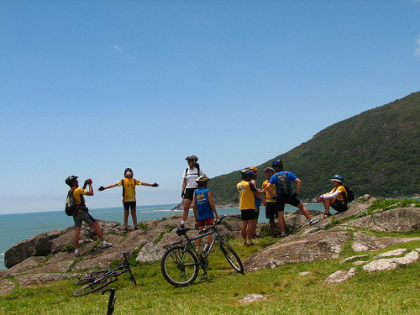 Photo by WHL - Florianopolis.
Photo by WHL - Florianopolis.Bars and Cafes
Restaurants
Nightlife
Information

How to Get There
By Plane
By Bus
By Car
 Brazzil Travel | Comments Off |
Brazzil Travel | Comments Off | 